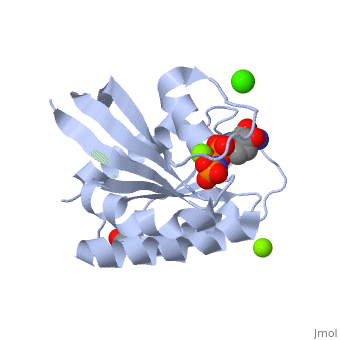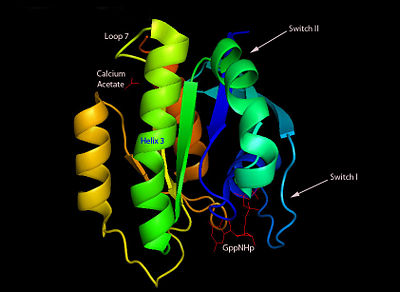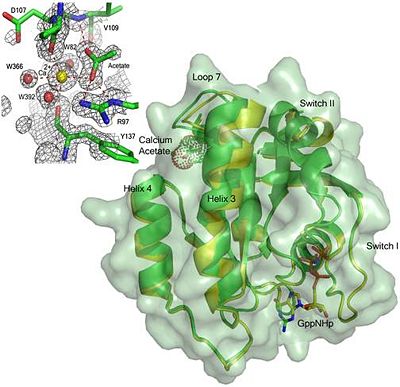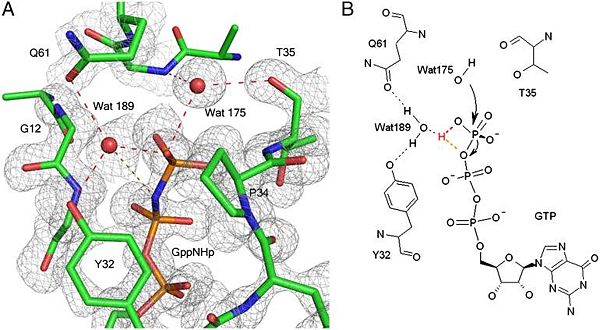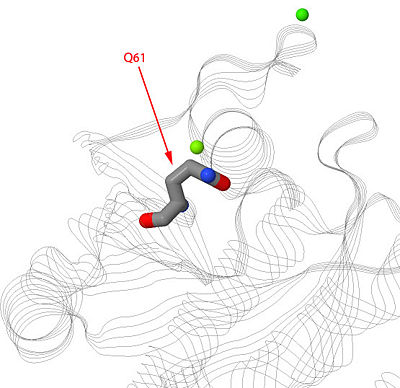Allosteric modulation of H-Ras GTPase
From Proteopedia
| |||||||||
| 3k8y, resolution 1.30Å () | |||||||||
|---|---|---|---|---|---|---|---|---|---|
| Ligands: | , , , | ||||||||
| Gene: | HRAS, HRAS1 (Homo sapiens) | ||||||||
| Related: | 2rge, 3k9n, 3k9l | ||||||||
| |||||||||
| |||||||||
| Resources: | FirstGlance, OCA, RCSB, PDBsum | ||||||||
| Coordinates: | save as pdb, mmCIF, xml | ||||||||
H-Ras is a small monomeric GTPase protein that is found inside of cells. It helps regulate cell division in cells through signal transduction pathways such as the mitogen activated protein kinase (MAPK) pathway. H-Ras is also known as a molecular switch, it contains two switch regions: Switch I and Switch II. Switch I is regions 30-40, Thymine 35 plays an important role in switch I region and switch II is regions 60-76, Glycine 60 plays an important role for switch II region. Both of these switches depend on the γ-phosphate group on a GTP molecule to turn “on” and “off”. In the Ras catalytic cycle, Ras is activated when it binds to a GTP molecule turning both switch regions “on”. This pathway also involves GTPase activating protein, which catalyzes the hydrolysis of the GTP molecule that is bound to Ras causing the switches to turn “off”. Ras was first discovered in a retrovirus which was known to cause saracoma in rats hence the name "ras" "rat saracoma".
Structure
H-Ras is 166 Amino Acids long with six beta sheets and six helices. One of the helix 2 is a 3/10 helix, unlike the rest of the helices. Also it contains a Calcium Acetate in the allosteric binding site that is located by the Loop 7 and Helix 3. The structure of Ras actually forms slightly different when it is and isn't bound to calcium acetate. The GTP molecule will then attach on the bottom of the protein inbetween the Switch I and Switch II region. The switch I and switch II regions change conformation between their active and inactive state. This change in conformation of the switch regions helps other proteins determine whether the Ras protein is active or inactive. During the inactive stage Ras is bound to GDP and in the active stage it is bound to GTP. The effector protein Raf will bind to Ras protein when Ras is bound to GTP allowing it to help in the MAPK cascade.
Calcium acetate plays an important role in the activation of Ras protein. When it is bound to Ras protein, it will cause the Loop 7 and Helix 3 to shift and bend towards it. This will change the conformation of the entire protein and more importantly it will open up switch I and switch II allowing the γ-phosphate of GTP to hydrogen bond with Q61, T35 and Y32 residues through a water molecule. Add more about binding of calcium acetate and how it bends the loop 7 and helix 3 to allow switch I and switch II to bind to the GTP moleculeMutations and Cancer
The residue Glutamine-61 (Q61) plays a large role in the mutation of the Ras protein. When the Q61 becomes mutated in stops the GTPase of the Ras causing the protein to continuously stay active. Mutated Q61 is found in many cancer patients.Mutation of Q61 causes a shift in Loop 7 and Helix 3 causing the conformation of the amino acids and switch regions to change.
Reference
- Buhrman G, Holzapfel G, Fetics S, Mattos C. Allosteric modulation of Ras positions Q61 for a direct role in catalysis. Proc Natl Acad Sci U S A. 2010 Mar 16;107(11):4931-6. Epub 2010 Mar 1. PMID:20194776
Categories: Homo sapiens | Buhrman, G. | Holzapfel, G. | Mattos, C. | Acetylation | Cell membrane | Disease mutation | Golgi apparatus | Gtp-binding | Lipoprotein | Membrane | Methylation | Nucleotide-binding | Oncoprotein | Palmitate | Prenylation | Protein-nucleotide complex | Proto-oncogene | S-nitrosylation
